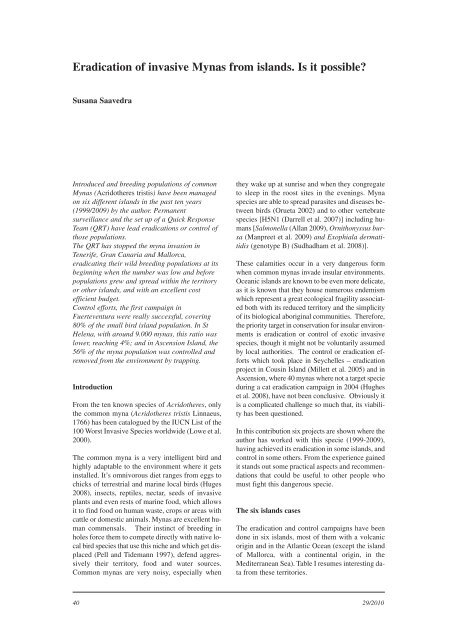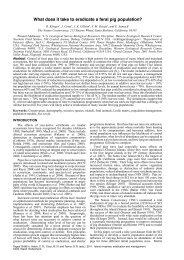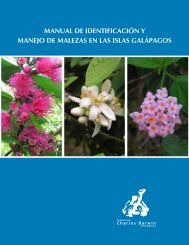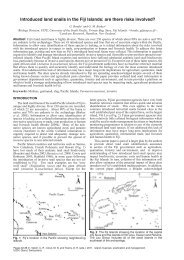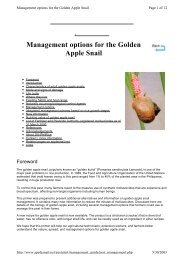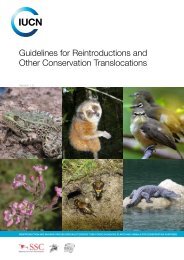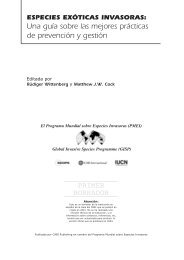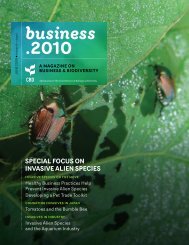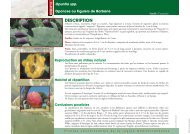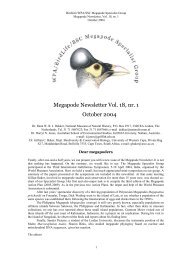Aliens Newsletter - ISSG
Aliens Newsletter - ISSG
Aliens Newsletter - ISSG
Create successful ePaper yourself
Turn your PDF publications into a flip-book with our unique Google optimized e-Paper software.
Eradication of invasive Mynas from islands. Is it possible?<br />
Susana Saavedra<br />
Introduced and breeding populations of common<br />
Mynas (Acridotheres tristis) have been managed<br />
on six different islands in the past ten years<br />
(1999/2009) by the author. Permanent<br />
surveillance and the set up of a Quick Response<br />
Team (QRT) have lead eradications or control of<br />
those populations.<br />
The QRT has stopped the myna invasion in<br />
Tenerife, Gran Canaria and Mallorca,<br />
eradicating their wild breeding populations at its<br />
beginning when the number was low and before<br />
populations grew and spread within the territory<br />
or other islands, and with an excellent cost<br />
efficient budget.<br />
Control efforts, the first campaign in<br />
Fuerteventura were really successful, covering<br />
80% of the small bird island population. In St<br />
Helena, with around 9.000 mynas, this ratio was<br />
lower, reaching 4%; and in Ascension Island, the<br />
56% of the myna population was controlled and<br />
removed from the environment by trapping.<br />
Introduction<br />
From the ten known species of Acridotheres, only<br />
the common myna (Acridotheres tristis Linnaeus,<br />
1766) has been catalogued by the IUCN List of the<br />
100 Worst Invasive Species worldwide (Lowe et al.<br />
2000).<br />
The common myna is a very intelligent bird and<br />
highly adaptable to the environment where it gets<br />
installed. It’s omnivorous diet ranges from eggs to<br />
chicks of terrestrial and marine local birds (Huges<br />
2008), insects, reptiles, nectar, seeds of invasive<br />
plants and even rests of marine food, which allows<br />
it to find food on human waste, crops or areas with<br />
cattle or domestic animals. Mynas are excellent human<br />
commensals. Their instinct of breeding in<br />
holes force them to compete directly with native local<br />
bird species that use this niche and which get displaced<br />
(Pell and Tidemann 1997), defend aggressively<br />
their territory, food and water sources.<br />
Common mynas are very noisy, especially when<br />
they wake up at sunrise and when they congregate<br />
to sleep in the roost sites in the evenings. Myna<br />
species are able to spread parasites and diseases between<br />
birds (Orueta 2002) and to other vertebrate<br />
species [H5N1 (Darrell et al. 2007)] including humans<br />
[Salmonella (Allan 2009), Ornithonyssus bursa<br />
(Manpreet et al. 2009) and Exophiala dermatitidis<br />
(genotype B) (Sudhadham et al. 2008)].<br />
These calamities occur in a very dangerous form<br />
when common mynas invade insular environments.<br />
Oceanic islands are known to be even more delicate,<br />
as it is known that they house numerous endemism<br />
which represent a great ecological fragility associated<br />
both with its reduced territory and the simplicity<br />
of its biological aboriginal communities. Therefore,<br />
the priority target in conservation for insular environments<br />
is eradication or control of exotic invasive<br />
species, though it might not be voluntarily assumed<br />
by local authorities. The control or eradication efforts<br />
which took place in Seychelles – eradication<br />
project in Cousin Island (Millett et al. 2005) and in<br />
Ascension, where 40 mynas where not a target specie<br />
during a cat eradication campaign in 2004 (Hughes<br />
et al. 2008), have not been conclusive. Obviously it<br />
is a complicated challenge so much that, its viability<br />
has been questioned.<br />
In this contribution six projects are shown where the<br />
author has worked with this specie (1999-2009),<br />
having achieved its eradication in some islands, and<br />
control in some others. From the experience gained<br />
it stands out some practical aspects and recommendations<br />
that could be useful to other people who<br />
must fight this dangerous specie.<br />
The six islands cases<br />
The eradication and control campaigns have been<br />
done in six islands, most of them with a volcanic<br />
origin and in the Atlantic Ocean (except the island<br />
of Mallorca, with a continental origin, in the<br />
Mediterranean Sea). Table I resumes interesting data<br />
from these territories.<br />
40 29/2010


